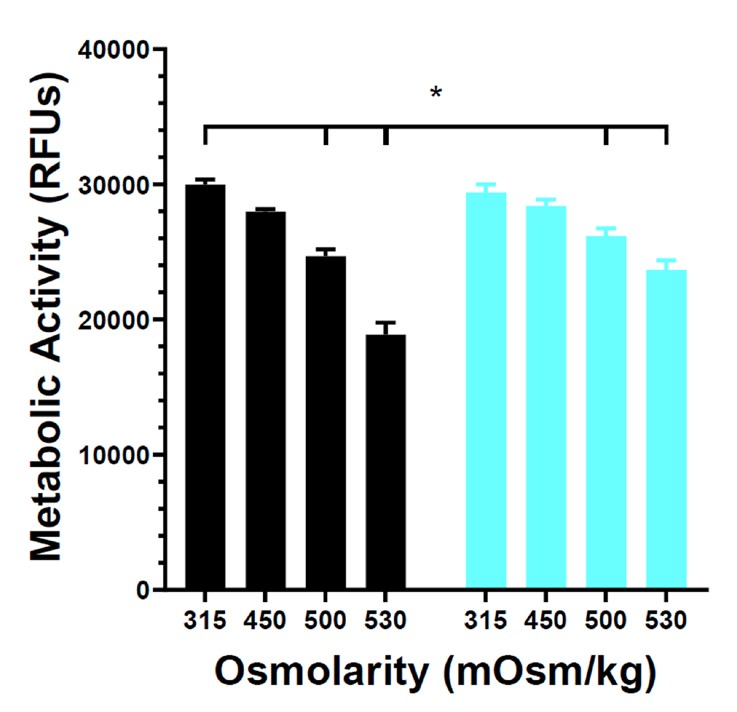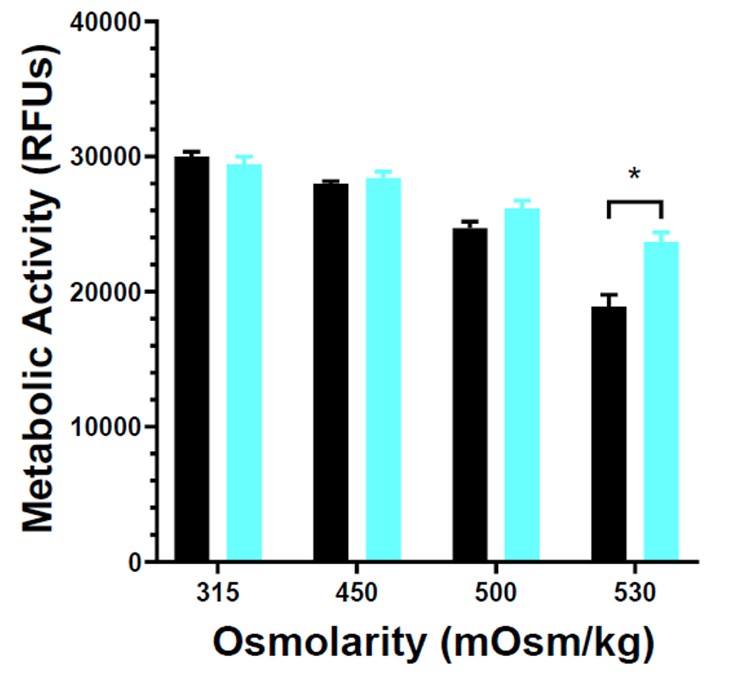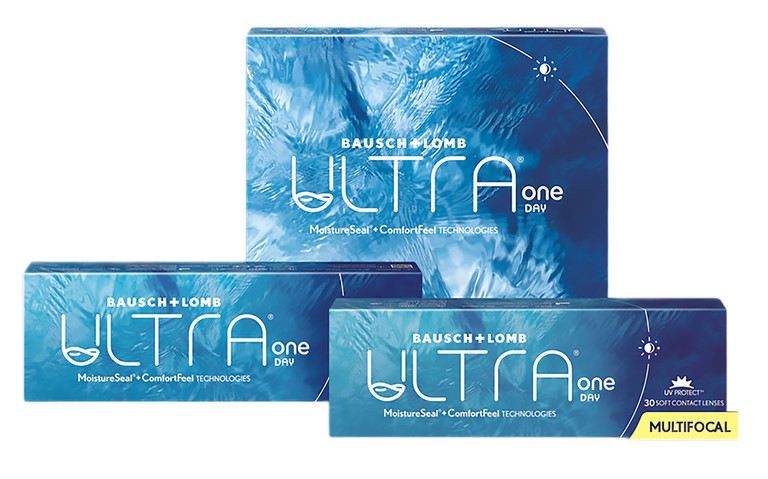mitechnology
ComfortFeel Technology: Combining Comfort and Eye Health Ingredients
WRITER Simon Hanna
Kalifilcon A silicone hydrogel contact lenses harness ComfortFeel technology, a proprietary formulation of ocular health ingredients designed to work in synergy with the lens material and provide a unique approach to ocular health and all-day comfort.
Maintaining the health of the ocular environment is an essential prerequisite for contact lens comfort throughout the day. However, this can be a challenge. Exposure to environmental irritants such as wind, dust, smoke, and allergens, as well as fluctuations in relative humidity, temperature, and air velocity, can alter the homeostatic environment on the ocular surface.1
Sustained, ongoing visual tasking on digital devices can lead to reduced blink rate and blink amplitude, which can impact tear film stability.2 Finally, the application of a contact lens itself causes further shifts in the ocular surface microenvironment.3
Several approaches have been used to reduce the impact of soft contact lenses on the ocular surface, for example, increasing wettability and oxygen transmissibility, changing lens replacement frequency, and material enhancements to reduce protein and lipid deposition.4 Building on these, an additional, innovative approach involves incorporating comfort and eye health ingredients into the contact lens itself.
COMFORTFEEL TECHNOLOGY: INGREDIENTS
Inspired by the TFOS DEWS II report,5 Kalifilcon A silicone hydrogel daily disposable contact lenses are designed to help maintain tear film and ocular surface homeostasis. The breakthrough ComfortFeel technology at work in these lenses consists of a proprietary combination of comfort and eye health ingredients, including osmoprotectants, moisturisers, and electrolytes, which are integrated into the lens material and released during lens wear to help protect, enrich, and stabilise the tear film.5,6
Differential dehydration associated with contact lens wear can result in changes to tear osmolarity. ComfortFeel technology contains two osmoprotectants – glycerin and erythritol – ingredients that help maintain ocular surface homeostasis under hyperosmotic stress.5,7 Two surfactant moisturisers – poloxamer 181 and poloxamine 1107 – support the lens in retaining hydration and in providing a smooth, wettable surface.8 This unique combination of moisturisers helps stabilise tear proteins under chemical conditions that would typically denature them, such as when they become bound to a contact lens surface. Data from laboratory studies show that ComfortFeel technology maintains the activity of tear protein lysozyme, in its natural, non-denatured state.8
Electrolyte balance is essential to tear film and ocular surface homeostasis because it helps maintain cell volume and fluid balance. The main contributors to tear film osmolarity are sodium, potassium, chlorine, magnesium, and calcium.3,5,6 ComfortFeel technology contains potassium chloride, to help maintain a stable and healthy ocular surface environment.7
OSMOPROTECTION WITH OSMOPROTECTANTS
Tear hyperosmolarity due to evaporation from the tear film can change the balance of the ocular surface environment. Erythritol and glycerin integrated into kalifilcon A material is designed to reinforce this balance.9
An evaluation was conducted by using transformed human corneal epithelial cells (THCEpiC) obtained from the American Type Culture Collection (ATCC) and maintained in EpiLife medium containing human corneal growth supplement.
The cells were seeded in a 96-well plate and incubated for 72 hours at 37°C, 5% C02 , and 95% relative humidity. The cell culture media was replaced with fresh baseline control medium, and the cells were incubated for an additional 24 hours under the same conditions.
Hyperosmolar medium was prepared and adjusted to four different osmolarity levels of 400, 450, 500, and 530 mOsm/kg using sodium chloride. To demonstrate the inhibition of pro-inflammatory cytokines/ chemokines with erythritol and glycerol, the hyperosmolar medium was tested with and without the addition of 0.9% erythritol and 0.9% glycerol to each of the four replicate well plates. The cells were incubated for 24 hours at 37°C, 5% C02 , and 95% relative humidity.
Two observations were made. Firstly, the metabolic activity of the cells was evaluated. Results have shown that metabolic activity of the THCEpiC decreases with increased sodium chloride osmolarity (Figure 1).


Figure 1. Metabolic activity THCEpiC cultured in baseline EpiLife control medium until confluent and exposed to hyperosmolar EpiLife medium in the absence (■ bars) or presence of 0.9% erythritol (■ bars) + 0.9%. Two-way ANOVA versus 315 m0sm/kg without ■ osmoprotectants using Dunnett’s multiple comparisons (*p<0.05).

Figure 2. Metabolic activity THCEpiC exposed to baseline control medium and hyperosmolar medium. Two-way ANOVA versus equivalent hyperosmolarity without osmoprotectants using Tukey’s multiple comparisons (*p< 0.05).
Additionally, the combination of erythritol and glycerol with the THCEpiC had significantly higher metabolic activity at 530 mOsm/kg than cells not receiving osmoprotectants (Figure 2).
As well, the cell culture supernatants from the THCEpiC culture were quantitated to detect cytokines including interleukin(IL)-6, chemokines IL-8, macrophage chemoattractant protein (MCP)-1, and MMP-9. At hyperosmolarity conditions in which metabolic activity was not impacted, pro-inflammatory cytokine/chemokine response was significantly reduced in cells receiving osmoprotection (Figure 3).
Results from these in vitro assays in THCEpiC strongly indicate that the combination of erythritol and glycerol demonstrate osmoprotective properties under hyperosmolar conditions. These osmoprotectants in Kalifilcon A silicone hydrogel contact lenses have potential to help stabilise the tear film during contact lens wear and reduce contact lens wear discomfort.
Figure 3. Pro-inflammatory cytokine/chemokine response in THCEpiC exposed to baseline control medium and hyperosmolar medium. A) Baseline metabolic activity of THCEpiC cultured in baseline EpiLife control medium until confluent and exposed to hyperosmolar EpiLife medium with the addition of NaCl in the absence (■ bars) or presence of 0.9% erythritol + 0.9% glycerol (■ bars); B) IL-6 response; C) IL-8 response; D0) MCP-1 response. Two-way ANOVA versus equivalent hyperosmolarity without osmoprotectants using Tukey’s multiple comparisons (*p < 0.05). Note: MMP-9 was assayed and was not detected in this experiment.
PASSIVE DIFFUSION AND COMFORTFEEL TECHNOLOGY
The components of ComfortFeel technology are integrated into the lens material during manufacture and released through passive diffusion during lens wear. Passive diffusion is the movement of molecules based on a concentration gradient. The rate of diffusion depends on the size, shape, and chemistry of each ingredient, as well as the lens polymer itself.
Diffusion will continue until the difference in concentration of the ingredients inside the lens, as compared with the environment outside the lens, becomes small, allowing some ingredients to remain in the lens to help provide long-lasting moisture and comfort.10
ALL-DAY WEAR
ComfortFeel Technology works synergistically with the Advanced MoistureSeal technology behind the Kalifilcon A lens material.10
Advanced MoistureSeal technology was developed using innovations in material chemistry to provide high oxygen transmissibility, high water content, low modulus, surface wettability, and moisture retention in the lens material.
The building blocks of the lens material are assembled through a two-phase polymerisation process. First, a unique combination of long and short-chain silicone polymers create a flexible matrix to provide oxygen transmission, structural integrity, and low modulus. Integrated into this silicone backbone are the hydrophilic components, dimethylacrylamide (DMA) and the humectant polyvinylpyrrolidone (PVP). Adding DMA and PVP during the polymerisation process of Kalifilcon A contact lenses results in a water content of 55%. A Class II ultraviolet (UV) blocking agent is also added to provide broadspectrum protection that blocks at least 50% of UVA rays and 95% of UVB rays.*11
“Inspired by the TFOS DEWS II report,5 Kalifilcon A silicone hydrogel daily disposable contact lenses are designed to help maintain tear film and ocular surface homeostasis”
The ability of a contact lens material to protect against dehydration is important for comfort and precision optics. Kalifilcon A lenses maintain 96% of their water content for a full 16 hours.12 The low modulus10 (0.5 MPa) of Kalifilcon A lenses also helps reduce the impact on the ocular surface and contributes to a comfortable lens wearing experience.13,14
Along with the high water content and the low modulus, Kalifilcon A contact lenses deliver a high level of breathability. This high oxygen delivery helps maintain white, healthy-looking eyes with an oxygen transmissibility (Dk/t) of 134 at the centre of a -3.00D lens.15
EXCEPTIONAL PATIENT SATISFACTION
Because Kalifilcon A lenses and the technologies behind them were developed with the intent of providing an exceptional contact lens-wearing experience by helping to maintain ocular surface homeostasis,10 it is vital that they stand up to the demands of real life and everyday activities.
A large multi-site study evaluated the performance of Kalifilcon A lenses among habitual silicone hydrogel soft contact lens wearers, aged 18 to 40, who wore test lenses for at least eight hours each day for two weeks. Participants completed an online survey after at least seven days of lens wear, assessing lens performance across a range of attributes, using a six-point agree/disagree scale and reporting hours spent on various daily activities.16
At baseline, a symptoms survey found that 180 participants self-identified as having contact lens-related dryness with their habitual lenses. This group of patients reported involvement in a variety of visually demanding activities, including substantial average daily screen time.17
These real patients reported an exceptionally positive wearing experience, suggesting that Kalifilcon A lenses may become the silicone hydrogel daily disposable lens of choice for many patients.
• 91% agreed that Kalifilcon A lenses felt incredibly soft, smooth, and weightless,
• 86% agreed that the lenses are comfortable throughout the day,
• 90% said that the lenses delivered comfortable vision throughout the day,
• 83% agreed that lenses were comfortable even when working for long hours at a computer, and
• 90% said that lenses felt comfortable when they were driving at night.17

“Results from these in vitro assays in THCEpiC strongly indicate that the combination of erythritol and glycerol demonstrate osmoprotective properties under hyperosmolar conditions”
Simon Hanna BOptom PGDACO PGCertOc Ther GCUT is the National Professional Services Manager at Bausch and Lomb in Australia.
* UV-absorbing contact lenses are not substitutes for protective UV-absorbing eyewear, such as UV-absorbing goggles or sunglasses, because they do not completely cover the eye and surrounding area. You should continue to use UV-absorbing eyewear as directed.
In accordance with the Medical Technology Association of Australia (MTAA) Code of Practice, Edition 13, 2023, Section 1.6, this article is a Company Commissioned Article (CCA).
References
1. Wolkoff P, Karcher T, Mayer H. Problems of the ‘outer eyes’ in the office environment: an ergophthalmologic approach. J Occup Environ Med. May 2012;54(5):621-31. doi: 10.1097/JOM.0b013e31824d2e04.
2. Coles-Brennan C, Sulley A, Young G. Management of digital eye strain. Clin Exp Optom. Jan 2019;102(1):18-29. doi: 10.1111/cxo.12798.
3. Craig JP, Willcox MD, Argüeso P, et al. The TFOS International Workshop on Contact Lens Discomfort: report of the contact lens interactions with the tear film subcommittee. Invest Ophthalmol Vis Sci. Oct 18 2013;54(11):TFOS123-56. doi: 10.1167/iovs.13-13235.
4. McMonnies CW. An amplifying cascade of contact lens-related end-of-day hyperaemia and dryness symptoms. Curr Eye Res. Jul 2018;43(7):839-847. doi: 10.1080/02713683.2018.1457163.
5. Jones L, Downie LE, Korb D, et al. TFOS DEWS II management and therapy report. Ocul Surf. Jul 2017;15(3):575-628. doi: 10.1016/j.jtos.2017.05.006
6. Willcox MDP, Argüeso P, Georgiev GA, et al. TFOS DEWS II tear film report. Ocul Surf. Jul 2017;15(3):366-403. doi: 10.1016/j.jtos.2017.03.006.
7. Bausch and Lomb. Data on file: Formulation considerations for UPS04. March 4, 2019. Sponsored by Bausch and Lomb.
8. Scheuer C, Barniack V, Rah M, Reindel B. Impact of a novel contact lens on maintaining the native state of a tear film protein. Poster presented at the Global Specialty Lens Symposium. 20–23 January 2021. Sponsored by Bausch and Lomb.
9. Data on file. Evaluation of erythritol and glycerin osmoprotection characteristics on an ocular surface cell line under hyperosmotic conditions. AAO Poster; 2020. Sponsored by Bausch and Lomb.
10. Data on file. Rah MJ. Ocular surface homeostasis and contact lens design. Feb 2021. Sponsored by Bausch and Lomb.
11. Section 510(k) premarket notification of intent to market: K200528: Bausch and Lomb Kalifilcon A soft (hydrophilic) contact lenses. United States Food and Drug Administration. 2020.
12. Schafer J, Reindel W. A clinical assessment of dehydration resistance for a novel silicone hydrogel lens and six silicone hydrogel daily disposable lenses. Poster presented at AAO; October 2020. Sponsored by Bausch and Lomb.
13. Tighe BJ. A decade of silicone hydrogel development: surface properties, mechanical properties, and ocular compatibility. Eye Contact Lens. Jan 2013;39(1):4-12. doi: 10.1097/ICL.0b013e318275452b.
14. Ozkan J, Willcox MD. The effect of lens modulus on insertion comfort with silicone hydrogel lenses. Invest Ophthalmol Vis Sci. 2011;52(14):6515-6515.
15. The Ultra Experience: Bausch and Lomb Ultra One Day contact lenses – A complete contact lens system, 2020. Sponsored by Bausch and Lomb.
16. Data on file. Background information on study 893: Product performance evaluation of a novel silicone hydrogel contact lens: Kalifilcon A daily disposable contact lenses - summary of kalifilcon a patient comfort and vision outcomes. 21 Jan 2021. Sponsored by Bausch and Lomb.
17. Data on file. Background information on study 893: Product performance evaluation of a novel silicone hydrogel contact lens: kalifilcon A daily disposable contact lenses - Summary of Kalifilcon A patient comfort and vision outcomes for patients who reported dryness with their habitual lenses. 22 April 2021. Sponsored by Bausch and Lomb.